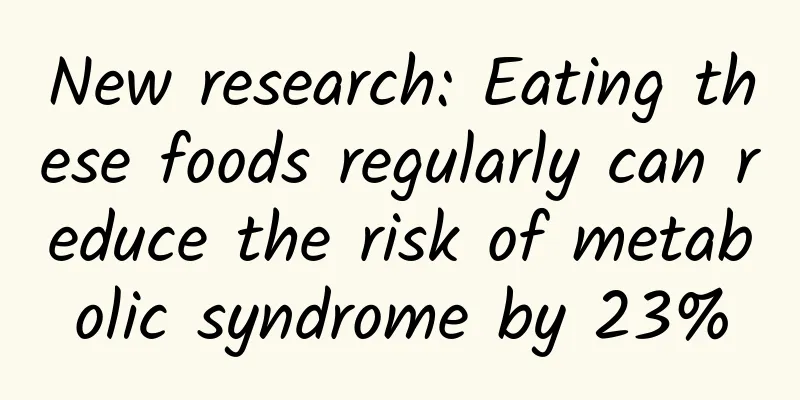New research: Eating these foods regularly can reduce the risk of metabolic syndrome by 23%

|
Compiled by: Gong Zixin Have you ever thought about A cup of fragrant coffee in the morning A piece of smooth chocolate in the afternoon A glass of red wine in the evening Even a piece of fresh fruit after the meal It may be your secret weapon against metabolic syndrome~ The latest research found that foods rich in polyphenols, such as grapes, strawberries, oranges, coffee, chocolate, wine, etc., not only satisfy the taste buds, but also reduce the risk of metabolic syndrome by up to 23%. This is a large-scale study linking the intake of polyphenols with the prevention of cardiometabolic problems. The results of the study were published in the Journal of Nutrition. Metabolic syndrome, a cluster of metabolic abnormalities and hormonal changes that are major risk factors for cardiovascular disease, is increasing in prevalence at epidemic rates worldwide. Metabolic syndrome is clinically diagnosed when at least three of the following conditions are present: abdominal obesity, high blood pressure, high blood sugar (hyperglycemia), high triglycerides, and high blood fats (dyslipidemia). Polyphenols are bioactive compounds with antioxidant and anti-inflammatory properties. "While previous studies have found a link between polyphenol intake and a reduced risk of metabolic syndrome, it has never been confirmed in such a large study sample (6,378 people) and over such a long time span (8 years)," said study co-author Isabela Benseñor, professor at the University of São Paulo School of Medicine in Brazil. "Our findings in this study leave no doubt that promoting a diet rich in polyphenols may be a valuable strategy to reduce the risk of cardiometabolic diseases and prevent metabolic syndrome." The study analyzed data from the Brazilian Longitudinal Survey on Adult Health (ELSA-Brazil), which has tracked about 15,000 public employees from six universities and research institutions in Brazil since 2008. Of the 6,378 participants analyzed, 2,031 had metabolic syndrome. "We plan to further study the role of polyphenols in the prevention of cardiometabolic diseases. What is known so far is the anti-inflammatory and antioxidant properties of polyphenolic compounds, as well as their possible positive impact on the gut microbiota," said Benseñor, coordinator of the ELSA-Brazil project. More than 8,000 polyphenols have been found in nature. The best known and most studied are: phenolic acids (found in coffee, wine), flavonoids (common in fruits, legumes and chocolate), lignans (found in seeds, oranges), and stilbenes (found in red grapes, red wine). The researchers conducted detailed interviews using questionnaires to understand the participants' dietary habits and the frequency with which they consumed 92 polyphenol-rich foods. To ensure accurate measurement of polyphenol intake, the study also took into account the impact of different cooking and processing methods. The main conclusion was that people who consumed the highest level of polyphenols (469 mg per day) had a 23% lower risk of developing metabolic syndrome compared with those who consumed the lowest level of polyphenols (177 mg per day). A similar reduction in risk was seen with phenolic acid, a polyphenol found in high amounts in coffee, red wine and tea. According to Carnaúba, the amount of polyphenols associated with a reduced risk of metabolic syndrome comes from total dietary intake. "Diversity in food is important because one of the reasons polyphenols may have health benefits is their ability to modulate the gut microbiome. This process can stimulate the growth of probiotics, or 'good' bacteria. However, the more diverse a person's dietary intake and sources of polyphenols, the better the impact on the gut microbiome, and thus overall health." The analysis also showed that a higher intake of flavan-3-ols was associated with a 20% lower risk of developing metabolic syndrome. Red wine was the main source of flavan-3-ols in the study sample, accounting for 80% of the total intake of the compound. Chocolate was also a significant source, accounting for 10%. The team also investigated the effects of polyphenols on other cardiometabolic disorders associated with metabolic syndrome, such as high blood pressure, insulin resistance and elevated triglycerides. “The results suggest that the impact of polyphenols on metabolism and heart disease cannot be ignored. Regardless of sex, age, smoking, and cardiometabolic risk factors such as physical activity, people who consumed more polyphenols were up to 30 times less likely to have high blood pressure or insulin resistance and up to 17 times less likely to have elevated triglycerides. Note: The cover image is a copyrighted image. Reprinting it may cause copyright disputes. |
<<: Do you always feel that your bowel movements are not clean? Your body may be quietly "warning"!
Recommend
What are the taboos of boiling Chinese medicine?
There are many taboos when using Chinese medicine...
The science behind hangovers is actually...
According to a report on the U.S. News Weekly web...
Have you fallen into the misunderstandings about scientific weight loss?
Weight is an important indicator for evaluating h...
In reality, how does technology change our lives?
Human beings have evolved from the most primitive...
Can thunderstorms cause asthma? Is "thunderstorm asthma" really caused by fear?
This is the 4926th article of Da Yi Xiao Hu If yo...
What are the medicinal values of shells?
I believe that when we were young, many of our fr...
Benefits of American ginseng and rock sugar soaked in water
Drinking more American ginseng and rock sugar soa...
What are blood diseases?
Blood health is very important to people. Once so...
This food is suddenly popular! But be careful...
As summer vacation begins, many children are attr...
What Chinese medicine can relieve qi?
Maybe many of us don’t have a clear understanding...
The flood season is here! Parents and children should be alert to these high-risk scenes that may cause drowning hazards →
During the flood season, children are more likely...
The efficacy and function of Lying Egg Grass
Blood is very important to our body. If too much ...
Will the number of cancer patients increase significantly? It is recommended to do these 5 things to actively increase your "anti-cancer ability"!
“In general, the incidence of cancer in my countr...
What are the effects and eating methods of Cordyceps
Everyone should know that Cordyceps is a very pre...









